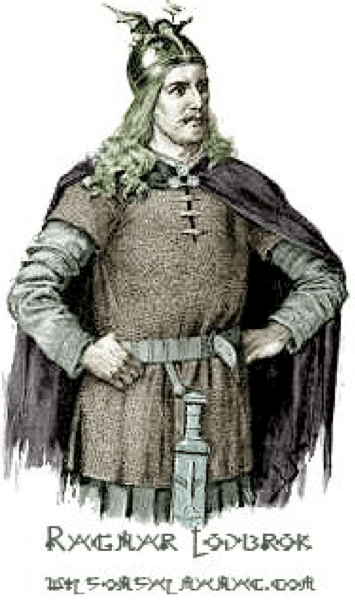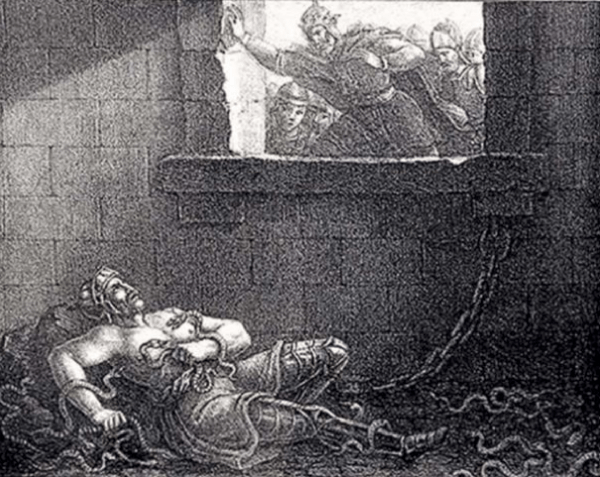The name Ragnor Lothbrok has been made famous in recent years by The History Channel series Vikings. The series sets Lothbrok up as the founder of a dynasty responsible for the expansion of Viking exploration – and the subsequent plunder and conquest for which the Vikings became so famous. Lothbrok is shown discovering new lands and plundering Paris. Chroniclers portrayed his death as the catalyst for the conquest of much of Saxon England as his sons Ivar, Ubbe, and Bjorn launch the invasion of the Great Heathen army upon the North of England as an act of vengeance.
The Vikings did indeed besiege Paris in 845 AD. Likewise, in 865 AD, what became known as the Great Heathen Army did invade the North of England and sweep down to the southern reaches of Anglo Saxon England. Ubbe, Ivar, and Bjorn are likewise verifiable as real historical characters. However, the figure of Ragnor Lothbrok is more shadowy. For the earliest documented tales of Ragnor Lothbrok are in European literature that was set down centuries after his death. So is Ragnar Lothbrok just a convenient legend used to give a context to the events of the Viking age? Or was he based on a real man?

The Legend Of Ragnar Lothbrok
The legend of Ragnar Lothbrok, sprang up wherever the Vikings settled. An Old Icelandic saga, the Ragnars saga Loobrokar, written in Old Norse sometime in the thirteenth century, provides the complete version of the story. However, legends of Ragnar and his sons also appear in a poem from the Orkney Isles, Háttalykill. Other earlier sources of Ragnar’s story are the Gesta Danorum written by the Danish historian, Saxo Grammaticus between 1188 and 1208. These various works, pieced together, allow us to reconstruct a rough narrative of Ragnar’s legendary ‘life.’
Ragnar was the son of the King of Denmark and later a king in his own right, famed for his heroic exploits- at home and abroad. The Gesta Danorum tells how he avenged the death of his grandfather, King Siward of Norway at the hands of the Swedish King, Fro. During this campaign, Ragnar met his future wife, Lagertha, “a woman with the courage of a man who fought fearlessly.” Ragnar was so impressed by Lagertha’s bravery that he decided to marry her. Lagertha however, was not so easy to convince, and Ragnar had to kill the bear and hound guarding her house to win her over.
Ragnar won another of his wives at the same time as he acquired the nickname. ‘Lothbrok”. This wife, Thora was the daughter of a powerful earl who had given her a little snake as a pet. However, the snake grew until it was a massive monster that terrorized the earl’s territory. Thora’s father offered his daughter to whoever could kill this lethal nuisance. Ragnar decided to try his luck. To protect himself from the snake’s venom, he donned a pair of woolly breeches coated in tar. Killing the snake and getting the girl, he earned himself a new name into the bargain: “Lothbrok” meaning “hairy breeches’.

Ragnar’s third wife outwitted him with her cleverness. Ragnar had sent his men to find food off the coast of Norway. They returned with stories of a beautiful girl called Kraka they had encountered at a nearby farm. Ragnar was intrigued and invited Kraka to join him. However, she was to appear neither naked or dressed, hungry or full or alone or accompanied. Kraka appeared covered in a fishing net and her own hair, having tasted food but not having eaten and with a dog for company. Impressed, Ragnar married her and Kraka revealed her true identity as Aslaug, daughter of the hero Sigurd and shieldmaiden Brynhild.
From these three wives, Ragnar had many sons and daughters. The most famous were Bjorn Ironside, Ivar the Boneless, Sigurd Snake in the eye and Ubbe. These sons would eventually avenge Ragnar’s death. Ragnar’s death came at the hands of King Aella of Northumbria who finally managed to capture Ragnar during one of his campaigns in the North of England. Unable to kill Ragnar with ordinary weapons, Aella flung Ragnar in a pit of snakes. There, Ragnar awaited his inevitable death, passing the time singing of his greatest victories, and boasting to his captors of how he would soon feast in Valhalla where “gladly shall I drink ale with the gods on the high benches.” In between, he promised his captors one thing: they would pay for his death.

